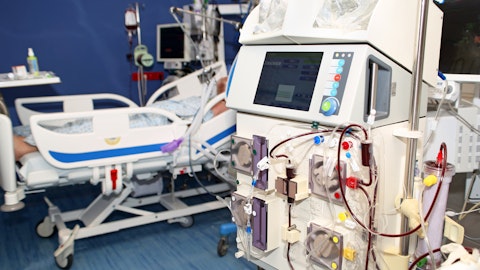And then adding more patients at the top of the funnel, as we talked about in the prepared remarks, by creating more new market entrants that are sending patients home, we are seeing movement there. We’re seeing new market entrants get into the business of home dialysis, who are kind of motivated by and attracted to the economics of home. And also, they’re starting to think about the journey to home, how do we get patients into the home? Where do they — how and where are they trained? How are they supported? They’re thinking about all those questions in really sort of different and creative ways. All of which I think will contribute to a greater patient flow direct to the home with a home first mindset. So, as with all things that are transformative, a transformation in the market this big is not — certainly not going to happen overnight.
We’ve always expected it to grow in a steadily linear fashion. But I do think all the right work is being done now, which we expect to feed a high double-digit growth rate far, far into the future for us on the home and the acute side for that matter.
Operator: Does that answer your questions.
Nabeel Ahmed: Operator, I think we can go to the next question. Thank you.
Operator: Okay. Thank you. [Operator Instructions] Our next question is a follow-up from the line of Shagun Singh from RBC Capital Markets. Your question, please.
Shagun Singh: Hey, Leslie. Thank you for squeezing me in. I was just wondering if you can talk a little bit about what the Street is missing about the Outset Medical story. And given where the stock is at, is there any change in strategy or anything you’re looking to do differently? Thank you for taking the follow-up.
Leslie Trigg: Sure. Happy to. Well, I think that as I look — take a step back and look at the Outset story, I see a couple of things. Number one, I see a market with very high barriers to success. We have now scaled to a point where we have scaled the high barrier and raised it for others, those who are already in the market and those who might be attempting to enter it. Two, I see a business that is predicated on a very high percentage of recurring revenue, which provides visibility, durability, and that percentage of recurring revenue will only continue to get greater in the future. I also see a market with incumbent competitors that are providing sort of services and products that health systems and patients are increasingly frustrated by and which are driving them to actively seek new solutions.
I think that the last point I’ll make is that this is about much more than a technology. It is about the ecosystem that we’ve built around Tablo that I spoke to in the prepared remarks. We have become in a proprietary way, exceptional at guiding hospital and health system customers through the change management process. We’ve become exceptional in moving and supporting patients in the home. We’ve become exceptional in our field service organization, our clinical support organization and our ability to educate and train physicians and nurses. And so perhaps if anything being underappreciated, maybe it is the recurring revenue element of the story. The unprecedented retention rate in the home and the strong gross margin gains that we’ve already made with a very, very clear road map now both to this next milestone to 50% gross margins and a very clear road map to a profitable business in addition to a high growth one.
Shagun Singh: Just any change in strategy or is it business as usual?
Leslie Trigg: Our strategy remains exactly the same. I think we are in the early innings of both acute and home. We’re very proud of the roughly 10% or 11% penetration we have on the acute side, but that leaves 90% to go. And so I think our strategy of focusing on what we call kind of land and expand, both landing new customers adopting in-sourcing with Tablo and delivering a product and team experience that motivates existing customers to expand within their network continues to pay dividends. And then on the home front, I think the strategy remains resonant at the mid-sized dialysis organizations continuing to deepen the patient census and volume in our existing programs and sort of similarly landing new market entrants at the top of the funnel who are very motivated to enter this business and provide patients with additional channels of access through which to go home.
So I think when we look at our growth, if I look, for example, at 60% growth just on the home console front in 2023, we feel very confident in the components and the commercial strategy at large moving through 2024.
Shagun Singh: Thank you so much.
Leslie Trigg: Of course.
Operator: Thank you. One moment for our next question. And our next question comes from the line of Joshua Jennings from TD Cowen. Your question, please.
Joshua Jennings: Hi. Good afternoon. Thanks for taking the question. I was hoping to just ask about the competitive counter marketing that was ongoing in 2023 and where that stands today. I believe it’s most impactful in some ICU settings and competitors inferring that Tablo XT is not appropriate for all care settings or just the dynamic between CRRT versus some of the on-label treatment types for Tablo. Has that died down or has your team been able to counteract that effectively? Where does that stand, Leslie?
Leslie Trigg: Yeah. Sure. Nice to hear from you, Josh. Well, in short, our team has done a really, really good job in responding to that. We were caught a little flat-footed as we’ve noted in Q3, Q4, but not so anymore. And I would also add that we have not necessarily seen any new competitive activity since then. We exist now in a competitive market. It’s not a surprise when we have taken as much market share and grown as fast as we have. So I would expect to see competitive activity, and we’re more ready for it today than we ever have been in the past. I would say that the other thing that we’re fortified by is the technology itself. Tablo is the only device in the market that can deliver dialysis therapy anywhere between 0 and 24 hours.


